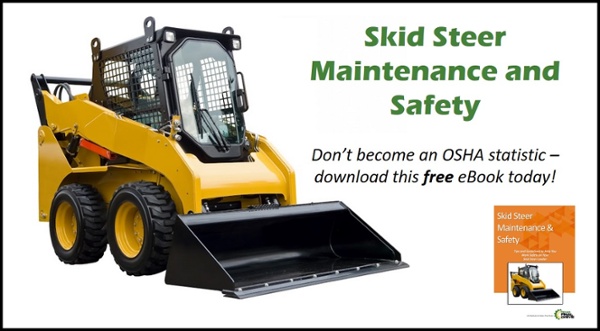Hydraulic systems are powerful and complex, which is why there is so much emphasis prioritizing safety during maintenance. Discover essential practices that ensure your safety and the longevity of you and your equipment.

An accident involving hydraulic fluid (or hydraulic equipment in general) can be serious (and sometimes fatal), so this Shop Talk Blog post deals with key safety practices.
Here are a few Shop Talk blog posts you might find helpful:
- Skid Steer Safety and Lift Arms
- Man Killed in Bobcat Skid Steer Loader Accident
- Unusual Excavator Accidents
Understanding the Basics of Hydraulic System Safety
Understanding the basics of hydraulic system safety is crucial for anyone involved in their maintenance, whether you're working on a skid steer loader or a mini-excavator. Most people think of the dangers involving hydraulic systems as they relate to operation but maintenance and repair can be just as dangerous when safety isn't made a priority. Everyone reading this knows that hydraulics operate under high pressure (and potentially high temperatures) and can pose significant hazards if not handled carefully. Accidents can vary by type and severity, with potential injuries including hydraulic injection, burns, cuts, breaks, more.
Personal Protective Equipment (PPE): Your First Line of Defense
Personal Protective Equipment (PPE) is essential when working on hydraulic systems. PPE includes gloves, safety glasses, face shields, steel-toed shoes, and protective clothing. These items protect you from high-pressure fluid leaks, flying debris, and other potential hazards. Experts also agree that wearing long pants and long sleeves also provides protection. Also, ensure that your PPE is in good condition and appropriate for the task at hand. For example, gloves should resist hydraulic fluids, and safety glasses should protect your eyes from high-pressure spray. Remember, PPE is your first line of defense against potential injuries.

Remember to remove rings and jewelry before working on your equipment, and tie back any long hair. Know where the emergency stops are, and DON'T WORK ALONE. You may need to get a CTL or mini-excavator back to working as soon as possible, but you can't run the equipment or repair it if you're in the hospital with an injury.
Proper Lockout/Tagout Procedures to Prevent Accidents
Releasing hazardous energy when working on equipment can be fatal. That's why Lockout/Tagout (LOTO) procedures are critical for ensuring safety during hydraulic system repairs: they prevent someone from being exposed to hazardous energy. These procedures involve isolating the hydraulic system from its energy source and placing a lock and tag on the system to prevent accidental re-energization before it is ready to be used again.

Before starting any maintenance work, ensure that the system is completely de-energized and that all residual pressure is released. Follow your organization's LOTO procedures strictly and verify that the system cannot be accidentally activated. This step is crucial for preventing serious injuries and fatalities. Remember that lockout devices are used to stop people from operating equipment that needs maintenance or repairs, while tagout is a second layer of protection.
High-Pressure Dangers
Hydraulic systems operate under extremely high pressure, which happens to be one of the keys to their operation. However, a sudden release of hydraulic fluid can cause serious injuries, including burns, lacerations, and even injection injuries, where fluid is forced into the skin. To mitigate these risks, always use caution when working near pressurized components.

Never place your hands or other body parts near potential leak points, and use appropriate tools (such as plywood or cardboard) to check for and locate possible leaks. If you suspect a leak, always depressurize the system before attempting any repairs.
Regular Inspection and Maintenance Schedules
Regular inspections and maintenance not only support the performance of your hydraulic equipment, but its safe operation as well. We recommend regular inspections to check for potential issues such as leaking seals or cracked hoses. And signs of wear and tear should always be recorded and mitigated as possible. In fact, we also recommend keeping detailed records of all inspections and repairs to track the system's condition over time.
Training and Education: Empowering Your Team
Training and education are vital components of a safe working environment. All team members, including operators and maintenance personnel, are trained in hydraulic system maintenance and safety procedures. This includes understanding the system's operation, recognizing potential hazards, familiarity with LOTO procedures, and knowing how to respond in case an emergency occurs.


